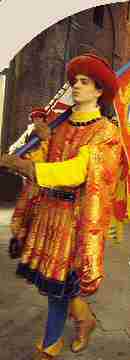There is something about Siena that feels like "home." This
is a place where we'd like to spend a lot more time.
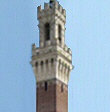

Siena has such a sense of living medieval history. Above is the wonderful Piazza del Campo, or simply Il Campo (literally, "the field," since it used to be an unpaved field). The Campo was paved with bricks made from local soil, giving them the color known world-wide as "burnt sienna."
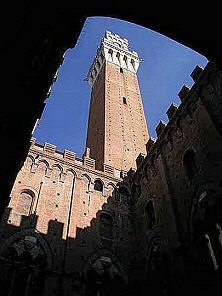
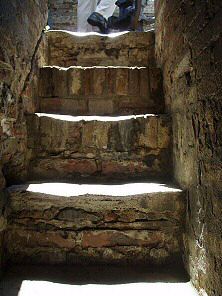 This plaza became anchor point for the town's
Contrade or neighborhoods and it flows down to the city hall which is
ornamented with Italy's tallest secular tower, the Torre del Mangia. We loved looking at the wear on the
increasingly narrower steps as we climbed the tower.
This plaza became anchor point for the town's
Contrade or neighborhoods and it flows down to the city hall which is
ornamented with Italy's tallest secular tower, the Torre del Mangia. We loved looking at the wear on the
increasingly narrower steps as we climbed the tower.
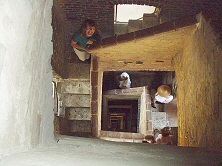
From the top of the tower, it is easy to see the shell shape of the piazza, divided into sections representing the medieval council of nine who ruled Siena at the time the campo was paved. The gray area surrounding the shell shape constitutes the race track for the infamous Palio. Horses representing the various Contrade are raced breakneck three times around the circuit. As they careen around the tight curves, they are somewhat protected by mattresses set to pad the sharpest turns. All for the glory of Mary... although the winning Contrada does take a little bit of pride in the accomplishment, as well...
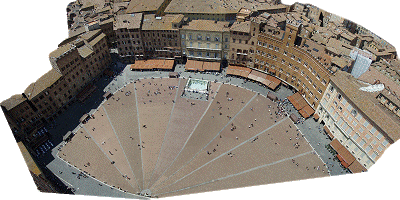
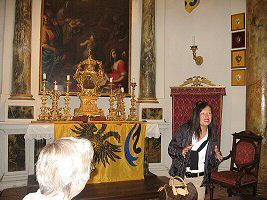
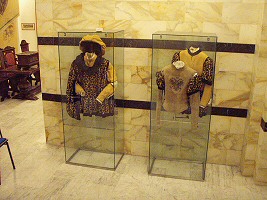 Speaking of the Palio and Contrade, our local guide in Sienna really did a great job of helping us understand the unique culture
and history that lives on today in their neighborhoods and their competitions.
We were able to tour one of the Contrada Association Historical Seats, referred
to by the members simply as Contrada. Although the neighborhood life is
changing due to the exodus from the city's increasingly expensive center, the
Contrada building is historically a communal home where objects of historic,
artistic, and archival value to the neighborhood are displayed. The Contrada
remains an integral part of life events such as births, weddings, and funerals.
Speaking of the Palio and Contrade, our local guide in Sienna really did a great job of helping us understand the unique culture
and history that lives on today in their neighborhoods and their competitions.
We were able to tour one of the Contrada Association Historical Seats, referred
to by the members simply as Contrada. Although the neighborhood life is
changing due to the exodus from the city's increasingly expensive center, the
Contrada building is historically a communal home where objects of historic,
artistic, and archival value to the neighborhood are displayed. The Contrada
remains an integral part of life events such as births, weddings, and funerals.
We were privileged to see a religious procession one night and witnessed the culture and the historic clothing in historical context (the Siena Part 2 video at the bottom of the page has more photos and a bit of video of the procession, shot with our digital camera).
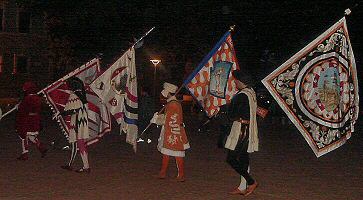
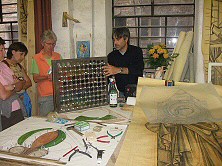
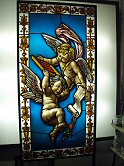 With all the cathedrals, baptisteries, and
municipal
buildings, there is an incredible amount of stained glass. Much is centuries old,
and more is created daily, so there is a fair amount
of work for people creating and restoring the glasswork.
Massimo Bracciali showed us how he and his brother make custom
stained glass windows and glass jewelry, and repair existing stained glass
windows.
With all the cathedrals, baptisteries, and
municipal
buildings, there is an incredible amount of stained glass. Much is centuries old,
and more is created daily, so there is a fair amount
of work for people creating and restoring the glasswork.
Massimo Bracciali showed us how he and his brother make custom
stained glass windows and glass jewelry, and repair existing stained glass
windows.
Glen has been talking about trying his hand at stained
glass for several years, and Massimo gave him the bug once again. It gnawed at
him for nearly an hour until he valiantly threw himself back into his
all-consuming study of
the ever-so-delectable, quintessentially Italian art form of gelato. It truly
is displayed like works of art. Three new flavors of gelati later, Glen had
forgotten once again about his plans to return home and finally start building
that stained glass window for the front door.
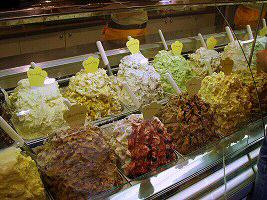
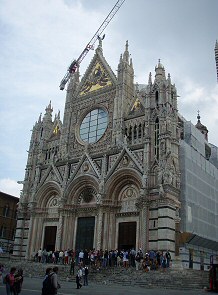 The duomo
is literally the highpoint of Siena. Every square inch of the large structure,
including the floor and ceiling, is covered or filled with beautiful art.
The duomo
is literally the highpoint of Siena. Every square inch of the large structure,
including the floor and ceiling, is covered or filled with beautiful art.
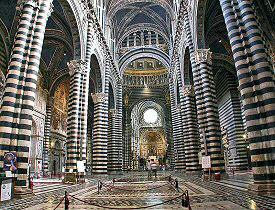
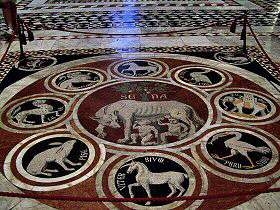
For those who think that Renaissance art is dark and dingy, you should know that
just the opposite is true. The misconception is largely due to decades of sooty
smoke build-up from the candles and open fires of the era. Restoration efforts
have often been
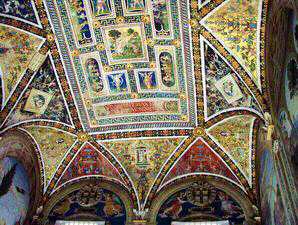
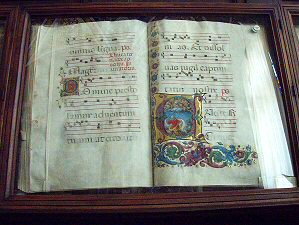 hindered by controversy over exactly what the original colors
and brightness were. The
Piccolomini Library
(frescoed ceiling shown at left, illuminated manu-script on display therein shown at right)
in the duomo gives testament to the brilliant luminosity of early Renaissance art.
The library was originally made to house the humanist collection of Cardinal Francesco Piccolomini Todeschini,
but the manuscripts never arrived. The library was closed off and never subjected to smoke damage, so its original
appearance remains largely intact.
hindered by controversy over exactly what the original colors
and brightness were. The
Piccolomini Library
(frescoed ceiling shown at left, illuminated manu-script on display therein shown at right)
in the duomo gives testament to the brilliant luminosity of early Renaissance art.
The library was originally made to house the humanist collection of Cardinal Francesco Piccolomini Todeschini,
but the manuscripts never arrived. The library was closed off and never subjected to smoke damage, so its original
appearance remains largely intact.
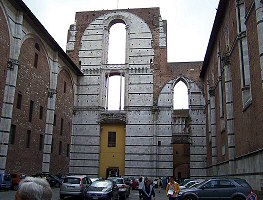 Big as the Siena duomo is, the plan was for it to be the largest of all,
especially larger then the duomo of arch-rival Florence. They planned to
convert the existing structure into a mere transept for the gargantuan new nave. You can see
from the unfinished entrance fašade shown here how far they got before the
plague decimated the population of Siena and changed their plans. A chilling thought,
but that devastation and the fact that Siena never recovered are why the city
retains its intrinsic medieval character and charm to this day.
Big as the Siena duomo is, the plan was for it to be the largest of all,
especially larger then the duomo of arch-rival Florence. They planned to
convert the existing structure into a mere transept for the gargantuan new nave. You can see
from the unfinished entrance fašade shown here how far they got before the
plague decimated the population of Siena and changed their plans. A chilling thought,
but that devastation and the fact that Siena never recovered are why the city
retains its intrinsic medieval character and charm to this day.
Click below to watch Siena Part 1 (4:28) |
Click below to watch Siena Part 2 (4:48) |
|

